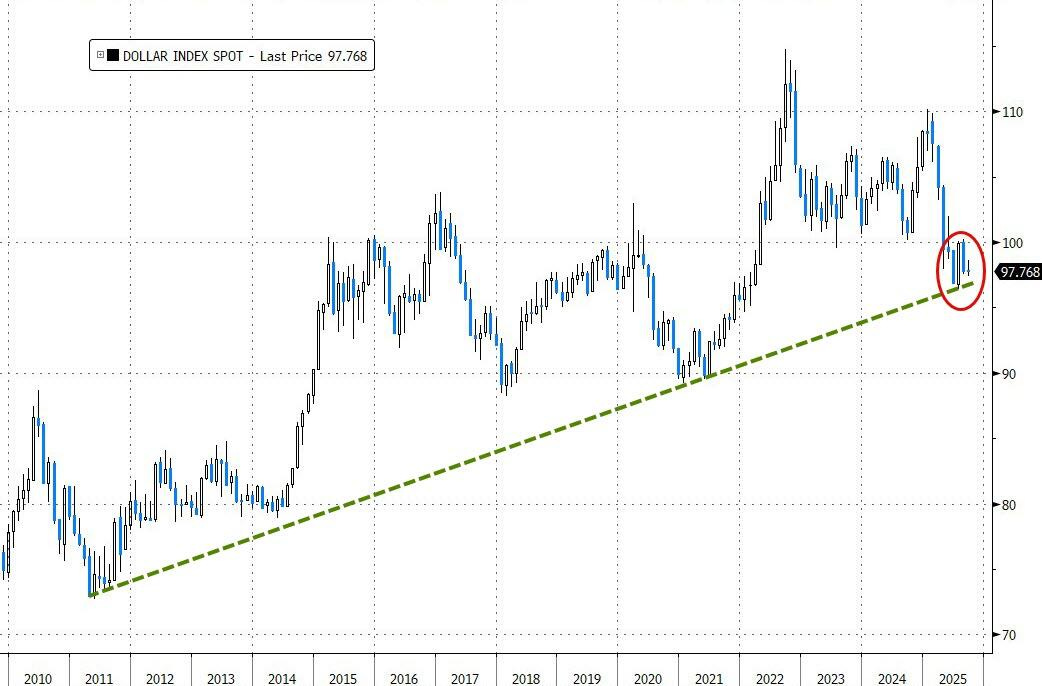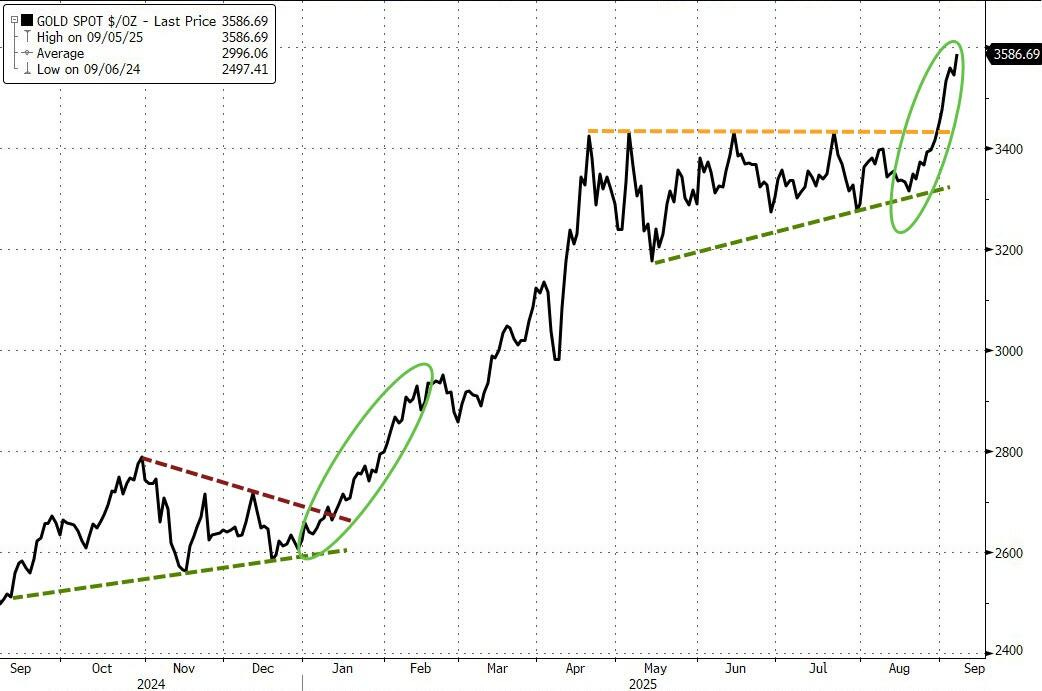The Week Ahead: Bad News—Still A Lifeline, Or Becoming A Lead Weight?
Markets opened Friday brimming with optimism, clinking glasses to the prospect of Fed rate cuts, but the celebration turned quickly into a hangover by day’s end. What began as a textbook “bad news is good news” rally—where weak jobs data implies easier policy—soon soured into a selloff, reminding traders that rate cuts are not a free lunch but often a byproduct of economic pain. This is the uncomfortable paradox: cuts may soothe the fever, but they rarely arrive without confirming the patient is already sick.
The Fed now sits in a vise. With its September 17th decision looming, it must weigh whether to deliver the soft landing balm of a 25bp trim or reach for the heavier 50bp cut—medicine that would soothe markets in the short run but all but admit the economy is deteriorating faster than policymakers expected. The “dot plot” will also make its appearance, laying bare governors’ collective outlook for growth, unemployment, and rates. Markets love the fantasy of multiple cuts, but each additional slice off the policy rate is also a confession of weakness, not strength.
Adding to the uncertainty is inflation’s ability to surprise. If the upcoming data run comes in hot, we could temporarily slip back into what traders call the “September Scaries,” where higher inflation collides with stretched equity valuations. A burst of sticky price data would quickly undercut last week’s bond rally, with yields snapping higher again. That leaves stocks, perched near all-time highs, in a precarious spot. My sense is that this sets the stage not for a new directional trend, but for sideways consolidation with a sell skew and a pick-up in volatility as the week unfolds. In Treasuries especially, brace for whipsaw: the tape can flip from relief rallies to sharp sell-offs in the space of an inflation or jobs headline.
Friday wasn’t just about bad news turning bad, or weak hands capitulating in MegaCap tech—it carried the fingerprints of seasonal flow as well. Funds often trim positions ahead of the September 15 tax date, and the typical month-end rebalancing cycle starts early. This time, those mechanics collided with a sector already under validation pressure. AI bellwethers like Nvidia (-3%), AMD (-5.5%), and Microsoft (-2.6%) have been under the cosh of late, and when the index heavyweights stumble, gravity does the rest. Still, the damage looked more rotational than catastrophic: the Russell 2000 managed to finish higher even as the Nasdaq, S&P, and Dow slipped modestly. It was less a rout than a reshuffling of chips—but the takeaway was clear. When the MegaCaps wobble, the whole market feels the tremor.
The bigger issue is how traders will price the coming sequence of data. Inflation still matters, of course, but it’s been demoted from headline act to supporting role. The jobless rate now commands the stage. CPI shocks can rattle bonds, but unless inflation runs egregiously hot, the Fed is likely to dismiss tariff pass-through as a one-off. Rising unemployment, however, forces a policy hand. And the revisions to last year’s payroll data—potentially as many as 750k fewer jobs than previously reported—hang like a storm cloud. If confirmed, that’s the kind of retroactive blow that could push the Fed toward the full 50bp option rather than the gentler 25bp trim.
So, what comes next? Think of it as a tightrope walk: stocks are balanced at near-record levels while traders peer nervously at the abyss below. Every economic print, every inflation tick, every payroll revision is a gust of wind testing the rope’s tension. Consolidation is likely, volatility is inevitable, and Treasuries are the instrument most vulnerable to sharp mood swings. For now, markets still hear a good vibe from the three cuts in 2025, and that melody cushions the downside. But traders are pragmatic. If the data darkens, they’ll punch their tickets for a 50bp cut in September without hesitation. The real question is whether the market continues to dance to the rhythm of “bad news is good news”—or whether, as Friday hinted, that tune has finally gone flat.
The Trader Lens: High Velocity, Uneven Week Leaves Dollar Shaky, Gold Gleaming
It was one of those weeks where the tape moved like a Formula 1 car—fast, noisy, but hard to tell if we were accelerating into a clean straightaway or skidding on a slick curve. Early on, equities strutted near their highs, volatility lay flat on its back, and the market’s mix looked like it was scripting a tech-enabled upswing into a presumed Fed cutting cycle. By the close, after payrolls injected a dose of reality, the story was less decisive: higher highs printed, then retraced, leaving traders scratching their heads on whether the market had sprinted too far ahead of itself.
The rhythm was unmistakable: high velocity, uneven beats, and more questions than answers.
The labor market data came in soft, confirming what most already sensed—the jobs engine isn’t firing as it once did. But that doesn’t mean the consumer has folded. Conference chatter suggested that while restaurants groaned and the low-end showed cracks, the higher-end continued to spend with surprising resilience. Think of it like a marathon runner with a pulled hamstring: still moving forward, just unevenly. Aggregate spending, for now, is holding up better than feared.
The AI narrative, once a one-way cheer, is now a genuine two-sided debate. Momentum in the leaders-vs-laggards pair trade has cooled, showing that the once unassailable front-runners can stumble. Yet this isn’t a wholesale rout. Google and Broadcom (AVGO) punched out fresh all-time highs, reminding us that in tech’s relay race, if one runner slows, another often grabs the baton. The cohort as a whole still manages to carry the weight, fueled by an unending carousel of localized debates.
The sharpest risk hiding in plain sight may be in hyperscaler capex. The AI boom has been powered not by abstract hopes but by real spending—servers, data centers, chips. Should that capex throttle back, infrastructure names could be the first casualties. If growth expectations rolled back to 2022 levels, models imply as much as 15–20% downside to the S&P 500. That’s the bear’s dream scenario. But reality tends to be messier: analysts have consistently underestimated capex, and any deceleration will be as much about timing as trajectory. The real test arrives in Q3 and Q4 earnings. Until then, the AI trade isn’t dead, but it needs proof—earnings uplift, real productivity gains—before the theme can broaden beyond the hyperscalers.
Perhaps the most intriguing chart of the week belongs to the dollar. The post-GFC uptrend was tested and held, but the cracks are showing. It’s as though the dollar is standing on a bridge built in 2009—still intact, but shaking under the weight of shifting flows. The next few weeks will tell us whether it remains a fortress or starts to crumble.
Against this noisy backdrop, the directional stance holds steady:
-
Not Adding Index Weight (will buy in at 1-2 % dip levels)—hedge where you can, because local technicals are worsening.
-
Dollar short—technicals suggest the once-mighty greenback is wobbling badly.
-
Stores of value long—gold’s chart is its own argument, gleaming like a safe harbor in turbulent seas.
-
Steeper G-4 curves—still biased toward steepening, and while not crowded, it’s clearly not being ignored.
More By This Author:
The Weekender: Bad News No Longer Tastes Like Comfort Food For Wall Street
Wall Street Dances On The Edge Of A Jobs Cliff
The September Scaries Return: Bonds Crack The Whip, Stocks Feel The Sting





